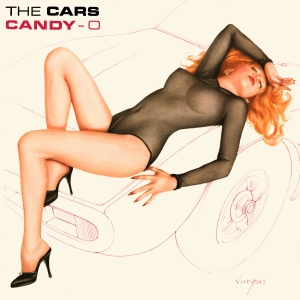

Candy-O
Studio album by The Cars
Released June 13, 1979
Recorded Cherokee Studios, Los Angeles, 1979
Genre New Wave
Length 36:25
Label Elektra
Producer Roy Thomas Baker
Professional reviews
* Allmusic 3.5/5 stars
* Robert Christgau (B+)
* Rolling Stone (not rated)
Candy-O is the second studio album by American new wave band The Cars, released in 1979.
Since the Cars had created a perfect album with their 1978 self-titled debut, it would be nearly impossible to top it. Instead of laboring long and hard over a follow-up like many '70s bands did after a huge commercial success, the band cranked out their sophomore effort, Candy-O, almost exactly one year later from the first LP. And while the album was not as stellar as its predecessor was, it did contain several classics, resulting in another smash album that solidified the band's standing as one of the most promising new bands of the late '70s.
The first single, the Top 20 anthem "Let's Go," proves to be the best track, but plenty of other standouts can be found as well. The title track remains one of the band's best rockers, while the gentle "It's All I Can Do" also deserved to be a hit. The band pays tribute to T. Rex on "Dangerous Type" (the main guitar riff resembles "Bang a Gong"), rocks out on "Got a Lot on My Head" and "Night Spots," shows their softer side on "Since I Held You," and embraces modern pop on "Double Life" and "Lust for Kicks." Their second strong release in a row, Candy-O proved that the Cars were not one-hit wonders, like so many other bands from the same era.
Cover art
The album cover was painted by artist Alberto Vargas, known for his paintings of pin-up girls that appeared in Esquire and Playboy magazines in the 1940s and 1960s. The idea to hire Vargas came from drummer David Robinson, the band's artistic director and a collector of pin-ups. The 83-year-old Vargas had retired several years earlier but was persuaded to take the assignment by his niece, who was a fan of The Cars. The painting, depicting a girl sprawled across the hood of a car, was based on a photo shoot directed by Robinson at a Ferrari dealership. The model, coincidentally named Candy, briefly dated Robinson afterward.
Track Listing
All songs written by Ric Ocasek.
Side One
1. "Let's Go" – 3:33
2. "Since I Held You" – 3:16
3. "It's All I Can Do" – 3:44
4. "Double Life" – 4:14
5. "Shoo Be Doo" – 1:36
6. "Candy-O" – 2:36
Side Two
1. "Nightspots" – 3:15
2. "You Can't Hold on Too Long" – 2:46
3. "Lust for Kicks" – 3:52
4. "Got a Lot on My Head" – 2:59
5. "Dangerous Type" – 4:28
Personnel
* Elliot Easton – lead guitar, backing vocals
* Greg Hawkes – percussion, keyboards, tenor saxophone, backing vocals
* Ric Ocasek – rhythm guitar, lead vocals on side one, tracks 2, 4 and 5, side two, tracks 1, 3, 4 and 5
* Benjamin Orr – bass guitar, lead vocals on side one, tracks 1, 2, 3 and 6, side two, track 2
* David Robinson – drums, percussion
Production personnel
* Roy Thomas Baker - producer
Packaging personnel
* Jeff Albertson - photography
* Ron Coro, Johnny Lee - art direction and design
* David Robinson - cover concept
* Alberto Vargas - cover painting
Singles from Candy-O
1. "Let's Go"
Released: June 12, 1979
2. "It's All I Can Do"
Released: September 25, 1979
3. "Double Life"
Released: December 11, 1979
Charts
Album
Year Chart Peak Position
1979 Billboard 200 3
1984 Billboard 200 179
Singles
Year Title Chart Peak Position
1979 "Let's Go" Billboard Hot 100 14
1979 "It's All I Can Do" Billboard Hot 100 41
Certifications
Organization Level Date
RIAA – U.S. Gold July 24, 1979
RIAA – U.S. Platinum August 6, 1979
RIAA – U.S. Triple Platinum April 5, 1995
RIAA – U.S. 4X Platinum December 15, 2001